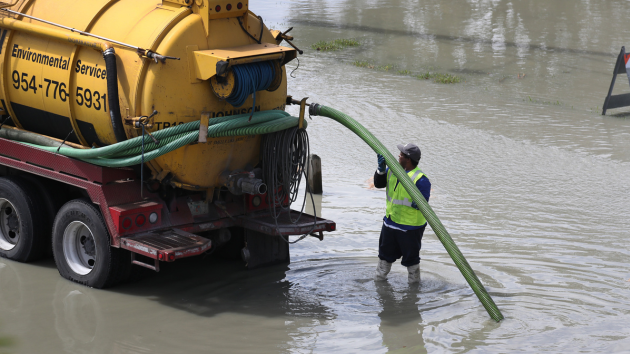(NEW YORK) — Sea level rise caused by climate change could cause thousands of toxic sites in the U.S. to flood in the coming decades, according to new research.
Under a high greenhouse gas emissions scenario, more than 5,500 hazardous sites across the U.S. will be at risk of a 1-in-100-year flood by the year 2100, according to a paper published Thursday in Nature. These sites include facilities that handle sewage, toxic waste, oil and gas and other industrial pollutants as well as formerly used defense sites, according to a paper published Thursday in Nature.
Of the the at-risk sites, at least 3,800 locations are projected to flood by 2050, the study found.
Many of the U.S. coastlines are heavily industrialized for a variety of reasons, including access to raw materials and proximity to open seas transportation, Lara Cushing, an associate professor of environmental health science at the University of California Los Angeles and lead author of the paper, told ABC News.
In the past several decades, extreme flooding events caused by storms like Hurricane Katrina in 2005 and Hurricane Harvey in 2017 flooded industrial facilities, releasing toxic chemicals into the floodwaters and air, Cushing said.
Researchers at UCLA put together a database of industrial and contaminated sites, such as sewage treatment plants, active oil and gas refineries and other types of industrial facilities — a total of nearly 50,000 sites across 23 coastal U.S. states and Puerto Rico, Cushing said. They then estimated flood risks at those locations for the years 2050 and 2100 under greenhouse emissions scenarios: high emissions and moderate emissions.
The findings indicate that the states at most risk of flooding at toxic sites include Florida, New Jersey, California, Louisiana, New York, Massachusetts and Texas. Those seven states account for nearly 80% of the hazardous sites at risk by 2100, according to the paper.
“That gives us a sense of where we might want to focus our efforts,” Cushing said.
If these sites were to flood, they could pose serious threats to public health and neighboring communities, according to the paper.
Oil-related infrastructure, such as refineries, ports and terminals, are particularly risky due to the possibility of oil spills but also because of the chemicals that are used to refine the oil, Cushing said.
The researchers also found that residents in marginalized communities will likely be impacted by flooding at toxic sites at higher rates.
The researchers defined neighborhoods across the U.S. into census block groups, classifying them as either being near at-risk sites or not near at-risk sites, but still in coastal areas, Cushing said. They then compared the census geography to different metrics of social marginalization or vulnerability to flooding related to adverse outcomes, such as income, housing tenure, linguistic isolation, access to vehicles and other demographic factors.
They found that low-income communities, communities of color and communities with low levels of voter turnout and access to vehicles are more likely to live near sites of future flood risk due to sea level rise, Cushing said.
Human-amplified climate change is the primary cause for present-day rising sea levels, according to climate scientists. Sea level rise is also accelerating, with the U.S. coastline projected to experience an sea level rise of about 11 inches, according to the federal government’s Fifth National Climate Assessment. That amount of sea level rise previously took 100 years to reach, between 1920 and 2020.
The Gulf Coast — especially in states like Louisiana and Texas — is of particular concern due to the high concentration of petrochemical industries in low-lying areas, increased threat of strong hurricanes and projected level of sea level rise in the region, Cushing said.
By 2050, the eastern Gulf Coast is projected to experience an average sea level rise of 8 to 12 inches, with an even greater increases of 12 to 16 inches along the western Gulf Coast, according to the Fifth National Climate Assessment.
Much of the risk of sea level rise is already locked in due to past emissions, the researchers said. But mitigation for global warming is needed to prevent the most drastic outcomes, Cushing said.
“The implications of our research suggests that this issues needs more attention, both in terms of mitigation plans and emergency preparedness and also things like cleanup plans and standards for legacy contamination,” she said.
In addition, coastal communities, including underserved groups, need access to critical data and resources in order to effectively fortify their resilience to climate change, said Rachel Morello-Frosch, a professor of environmental health sciences community health sciences at UCLA and co-author of the paper.
“There are potential solutions, if policy makers are ready to move forward,” Morello-Frosch said in a statement. “And there is a clear need for disaster planning and land-use decision-making, as well as mitigation strategies to address the inequitable hazards and potential health threats posed by sea level rise.”
Copyright © 2025, ABC Audio. All rights reserved.







